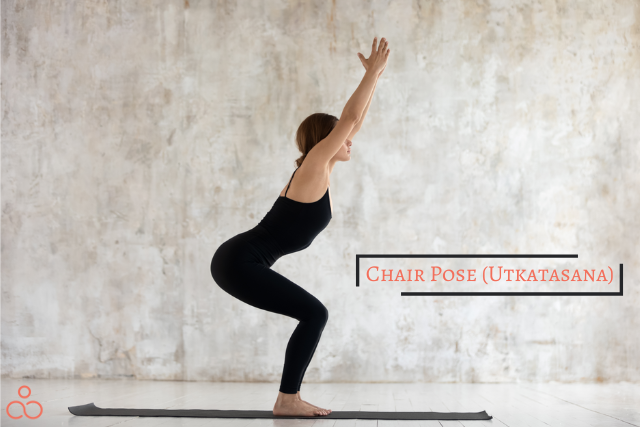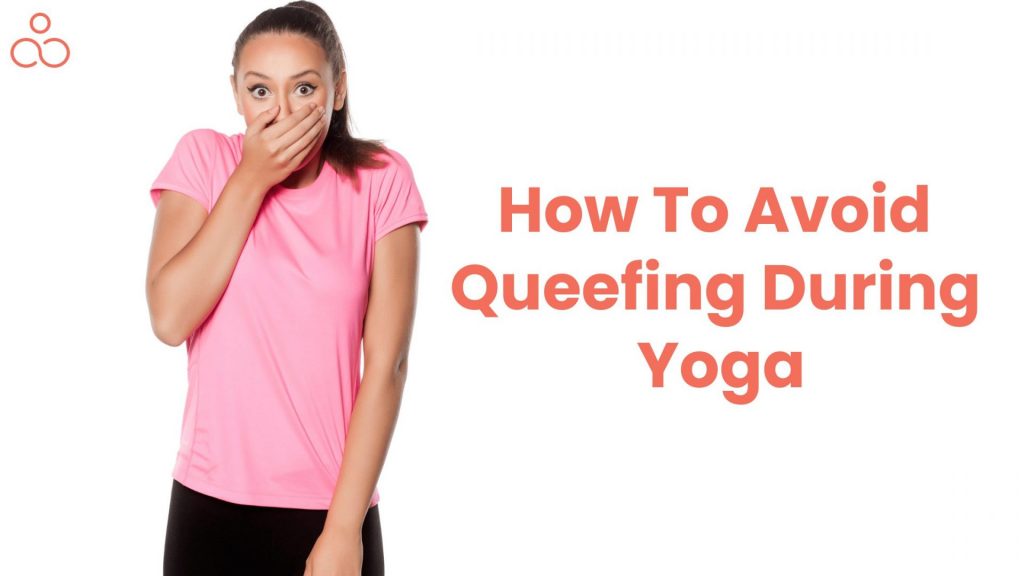Many people know about yoga and its various benefits, but few talk about queefing, or vaginal flatulence, during yoga. This can be an unpleasant and embarrassing issue for women, but some practical methods exist to tackle it. This article will explore how to avoid queefing during yoga sessions. Our ultimate goal is to provide women with helpful advice on reducing or avoiding queefing during their yoga practice.
What is queefing?
Vaginal gas or queefing is when air gets trapped in the vagina and is later released, creating a sound similar to passing gas. It’s a normal and involuntary bodily function that can happen to anyone, anytime. While it might be embarrassing, it’s harmless and widespread. However, if it occurs with other more severe symptoms, it could be an ensign of an underlying health condition. So, don’t worry if you experience it and know that it’s totally normal. In fact, results from a 2009 survey of 3000 Dutch women aged 45-85 showed that 12.8% of the sample had experienced queefing.
Queefing: The Meaning Behind the Term
A vaginal fart is commonly known as a queef. It happens when air escapes from the vagina, usually during or after sex or specific physical movements. “queef” comes from an old English term for a puff of air, like a tobacco pipe. It’s important to note that some people mix up the period queefing with another old phrase, “quiffing,” which means paying for sexual services.
Is Queefing Associated with Pain?
Suppose you have pain or unusual sensations in your vagina. In that case, it may be a symptom of a vaginal fistula or another underlying condition. In most cases, trapped gas inside your vagina isn’t a cause for concern. However, it’s always best to contact your healthcare provider if you have any problems or symptoms of a vaginal fistula. They can provide the necessary evaluation and care.
Identifying the Signs of Vaginal Gas: What to Know
When experiencing vaginal gas, you may hear and feel air escaping similarly to a fart. There may be a sensation of trapped gas before it exits your vagina. Unlike flatulence, there is no odor associated with vaginal gas as it is not related to the digestive system. However, queefs typically only last a few seconds.
Cause of Queefing: Understanding Why It Happens
There are a few causes of air getting trapped in your vagina. The most common of them are:
- Physical movement: If you participate in yoga, exercise, or running, your vagina might stretch or open slightly. Unfortunately, this can sometimes result in trapped air, leading to discomfort. During any physical activity that involves stretching or movement of the pelvic muscles, air might become trapped in the vagina, leading to vaginal farts. Surprisingly, research reveals that yoga, in particular, is associated with an increased likelihood of these spontaneous emissions.
- Pelvic exam: During a pelvic exam, passing gas through the vagina is a common occurrence. This is caused by introducing air into the vagina when your provider uses a speculum to check its interior. A speculum is a device used by healthcare professionals for examining the vagina.
- Vaginal fistulas: They can form when a connection develops between the vaginal canal and other urinary or digestive organs. This may be caused by trauma, certain diseases, or even after surgery. A vaginal fistula can cause a few symptoms: episodes of urinary or fecal incontinence and the release of smelly urine or gas from the vagina.
- Weak pelvic floor muscles: These can contribute to vaginal flatulence, a common issue caused by factors like menopause and childbirth. When the muscles located in the pelvic floor are weakened, air can more easily escape the vagina, leading to embarrassing sounds.
- Tampons and menstrual cups: When you insert a tampon or menstrual cup during your period, air will get pushed inside your vaginal canal. When you take out the tampon or cup, the air will escape, which could cause you to queef.
- Sexual activity: As your partner, toy, or finger moves in and out of your vagina during sex, the air is forced in. When you switch positions, this happens more often. Afterward, when the air comes out, you’ll experience vaginal gas.
- Pregnancy: Vaginal farts, or queefs, are common in pregnant women. The reason behind its occurrence is still unknown. However, it is common to experience more queefs after giving birth, especially when the pelvic floor muscles become weaker.
What Makes Queefing Worse: 3 Conditions to Watch Out For
Prolapse
When it comes to queefing, the location of our organs is also a factor to consider. If our organs are correctly positioned, the risk of experiencing queefing is substantially lower. Conversely, the situation shifts if we have a prolapse or a retroverted uterus. This condition allows air to enter the vagina more efficiently, ultimately resulting in air passing through the vaginal opening.
Constipation
If you experience occasional constipation, you may also notice vaginal flatulence due to the proximity of the rectum and vagina. Hard stool in the rectum can block the vaginal opening, causing trapped air to escape. Suppose you find yourself experiencing frequent vaginal flatulence or leakage of urine or stool into the vagina. In that case, it’s essential to consult with your gynecologist to check for a possible vaginal fistula.
Age
As women age, the elastic quality of their vaginal tissues tends to decrease. Pelvic floor muscles support the bladder, rectum, and uterus. Still, if these muscles weaken, they can no longer perform their job correctly, leading to more fart-like sounds. That weakening can be caused by giving birth, growing older, or having specific health conditions. Extra air can get caught in the vagina. As a result, they are leading to an increased chance of this happening.
Exploring the 6 Stages of Queefing in Yoga Class
The 6 Stages of Queefing in Yoga Class:
- Denial – First, you may pretend that nothing happened and hope that no one noticed the embarrassing noise.
- Panic – As reality sets in, you start to panic and wonder how to escape the situation without anyone noticing.
- Blame – You may try to blame the noise on something or someone else, like a squeaky mat or a passing gust of wind.
- Acceptance – Eventually, you realize that queefing is a natural function of the body and nothing to be ashamed of. You accept what happened and move on.
- Laughter – The incident may lead to laughter and jokes if you’re in a supportive and lighthearted yoga class.
- Relief – Finally, the queefing incident is over, and you can return to focusing on your practice without any further embarrassment.
How to avoid queefing during yoga?
- To avoid any unwanted air in your vagina while doing yoga or Pilates, engage the muscles around your anus and vagina before getting into the pose and keep them engaged throughout the pose.
- Strengthening your pelvic floor can be easily achieved through Kegel exercises, which can be done anytime and anywhere. This exercise provides excellent benefits and can be practiced separately, outside group classes.
- To keep group yoga classes comfortable for everyone, it’s best to refrain from doing poses that might make others uncomfortable. You can practice those poses in the privacy of your home or try a variation of the pose instead.
- Remember, people may choose not to participate in certain poses for various reasons, and it’s important to respect their privacy and not ask why they’ve decided not to do it.
- Yoga can be practiced in many ways, including outdoors and in water. When the weather is nice, you can give outdoor yoga classes a try to enjoy nature while you practice. Plus, the ambient noise can help mask any body noises during the course.
- If you’re feeling adventurous, try water yoga – it’s great to do in water up to chest or belly button depth.
- It’s perfectly normal to queef – it happens to everyone at some point! So, if you experience a loud queef in public, don’t be embarrassed; laugh it off and move on.
- In particular, if you’re in a relaxed setting like a class, you don’t need to be too worried about it. Everyone understands that these things happen!
- Yoga relies on the connection between your body movements and your breath. Change your breathing pattern to avoid excess air in your body as you move between poses. Exhale instead of inhale when lifting your hips.
- To engage your muscles, focus on drawing your navel towards your spine instead of tensing up your stomach. Doing this while lifting can reduce how much air enters your body, decreasing the chance of suffering from a vaginal fart.
- If vaginal flatulence during yoga causes distress, feel free to take a break from poses that might trigger it in class. Or, you can prepare yourself mentally that it’s a perfectly normal bodily function and there’s no need to be embarrassed.
- If you skip certain poses due to flatulence, you can practice them at home while looking for ways to prevent them. It’s perfectly okay to avoid poses during yoga class, just like many women don’t do inversions during their period.
Two Effective Exercises To Prevent Queefing
Mula Bandha Exercise
One way to strengthen your practice is to use mula bandha, called the “root lock.” The process involves lifting and pulling the pelvic floor muscles upwards and inwards, not tightening them. Once you’ve done it correctly, you’ll feel it in your lower abdomen. With practice, this technique will become easier. It is essential in Ashtanga yoga, as it helps with inversions by providing power and stability. Furthermore, if you can keep the technique throughout the pose, it can prevent air from entering or leaving your vagina. This can be especially helpful when you come out of an inversion.
Kegel Exercise
Practicing Kegel exercises outside of class is recommended, as this can help strengthen your pelvic floor muscles. Men and women who have undergone surgery or have urinary incontinence can particularly benefit from this exercise. Fortunately, the Kegel exercise is easy; you can do it anytime, anywhere. Combined with concentrated mula bandha, it can help improve your pelvic floor control and even prevent varts. For added resistance, vaginal weights are available – although research has suggested that these are not more effective than regular Kegel exercises.
When to Seek Treatment for Vaginal Flatulence?
Vaginal gas is a regular occurrence, especially during or after sexual intercourse, but it may also signal an underlying condition. It is advisable to go for medical treatment if you’re experiencing regular vaginal gas that isn’t related to sexual activity or if you have any of the following symptoms accompanied by vaginal gas: pain during sex or in the vagina, vulva, or perineum, foul-smelling vaginal odor, frequent urinary tract infections (UTIs), or leakage of pus or fecal matter from the vagina. A gynecologist can help diagnose the problem and provide treatment if needed.
How a Healthy Pelvic Floor Can Decrease Queefing?
- A robust pelvic floor prevents air entering the vaginal cavity during physical activities like yoga.
- By keeping the vaginal opening tight and avoiding the build-up of air inside, the pelvic floor and diaphragm must function in harmony during inhalation and exhalation. To loosen the pelvic floor muscles:
- Imagine them sinking when inhaling and returning to a restful tension on exhalation.
- Before getting up from a lying position, exhale to contract the pelvic floor, thus closing the vaginal opening and preventing any embarrassing noises.
- Inhale and let the pelvic floor relax, allowing any trapped air to escape silently.
Why Me Though?
If you’re a female, you’ll likely experience queefing at some point. This is normal and happens to women everywhere. However, if you have weak pelvic muscles (commonly postpartum), you may find queefing occurring more frequently. The good results are from air filling up in the vagina during intercourse. Even yoga instructors can’t avoid the ‘Vart!’ It’s important to note that any inversions or poses requiring abdominal and pelvic strength will likely result in the same sound. If you want to be prepared, it’s best to get used to a bit of noise!
The Upside of Queefing
A sign of a well-nitrogenized vagina is queefing, which indicates healthy vaginal tissue. Estrogen plays a crucial role in maintaining the elasticity and rugae of the vagina. These folds help in trapping air and causing the vibration of the vaginal walls, leading to the release of trapped air. In other words, queefing is nothing to be ashamed of; instead, it is a sign of a healthy vagina.
Queefs During Yoga Practice
Suppose you hear fart-like noises coming from your vagina during exercise or yoga. In that case, it’s probably due to air being sucked in along with the vagina as you do certain poses, like the half-shoulder stand and downward-facing dog (where your pelvis is higher than your shoulders). Women with weak pelvic floors tend to be more vulnerable to this because the air flows in more easily. When the pelvis is lower, the trapped air tries to escape, but the weak or tight pelvic floor can’t stop it.
Yoga poses to keep your flower strong.
Prasarita padottanasana or Wide Stance Forward Bend Pose
Prasarita padottanasana is a yoga pose that helps strengthen the pelvic floor muscles, potentially benefiting vaginal strength. It involves standing with legs wide apart and bending forward to touch the ground while keeping the back straight.
Baddha Konasana or Bound Angle Pose

Baddha Konasana involves sitting with the soles of the feet together and bringing them toward the pelvis while gently pushing the knees toward the ground. It can help improve blood circulation in the pelvic region and stimulate the ovaries, benefiting reproductive health.
Chakrasana or Wheel Pose
Chakrasana, more commonly known as the wheel pose, is a yoga posture that can help boost the pelvic floor muscles. Ultimately, this exercise can increase vaginal strength and improve overall vaginal health.
Dhanurasana or Bow Pose

Dhanurasana, also known as the Bow Pose in yoga, can improve blood circulation to your pelvic region, which can indirectly help in maintaining the strength and health of your vagina muscles. Additionally, this posture also helps strengthen the abdominal and back muscles, which can positively impact overall pelvic health.
Supta Vajrasana or Supine Thunderbolt Pose
Supta Vajrasana is a yoga pose that involves sitting on your knees and lowering your upper body back towards the floor with your arms straight behind you for support. This pose is believed to help strengthen the pelvic floor muscles, which can improve vaginal health and prevent conditions such as urinary incontinence.
Utkatasana or Chair Pose

Utkatasana, also known as Chair Pose, engages and strengthens the pelvic floor muscles, which can lead to improved vaginal health and tone. Additionally, the pose can increase blood flow to the pelvic region, benefiting vaginal health.
Upavistha Konasana or Wide Angle Seated Forward Bend Pose

Upavistha Konasana, also known as wide-angle seated forward bend, improves pelvic floor strength and flexibility. This can indirectly help in strengthening the muscles around the vagina. Additionally, the pose can also aid in relieving menstrual discomfort and promoting better blood circulation in the pelvic region.
Utthan Pristhasana or Lizard Pose

Utthan Pristhasana, also known as lizard pose, is a yoga posture that targets the hips and pelvis. This pose can help strengthen pelvic muscles, engaging the inner thigh muscles and stretching the hip flexors. Regular practice of this pose and other yoga poses that target the pelvic area can help improve pelvic floor strength and overall pelvic health.
Eka Pada Rajakapotasana or Pigeon Pose

Eka Pada Rajakapotasana is a posture that focuses on strengthening the pelvic muscles. The pose engages the transverse abdominal muscles and the internal oblique muscles to support the body as it folds forward. The hip flexors also play an essential role in the pose, as they are responsible for lifting the leg up. The abdominal muscles are necessary for maintaining good posture and can also help to support the spine. Eka Pada Rajakapotasana is an effective pose for strengthening the pelvic muscles and increasing flexibility.
Setu Bandha Sarvangasana or Bridge Pose

Setu Bandha Sarvangasana involves lying on your back with your knees folded and your feet flat on the ground. You then lift your hips up towards the ceiling while keeping your feet and arms rooted on the floor. By holding this pose and repeating it regularly, you can target and strengthen the muscles in your pelvic region.
FAQ’s
Should You Choose Kegels or Tampons?
If you want to improve control over your pelvic floor muscles, Kegel exercises are the way to go. However, please note that using tampons during yoga is not recommended because of potential risks like Toxic Shock Syndrome. To get the same benefit safely, try Kegel tools or weights. These tools are inserted into the vagina and help the muscles become more robust by making them work to hold them in place. And if you feel uncomfortable or embarrassed to do certain poses in public, don’t worry.
Can you do yoga squat without queefing?
If you are a yoga enthusiast you may be familiar with how each pose of yoga contributes to your overall health. One such pose being yoga squat also makes you worry about how to do it effortlessly without queefing. Although it can be quite tricky to get it right but don’t worry you’ll definitely be able to get the most out of it without any embarrassment and for that you need to understand how to do it properly to get the actual yoga squat benefits. If you want to avoid queefing during yoga squats then you must engage your pelvic floor muscles as it can help control the release of air. Focus on your breath during the yoga squat and try to synchronize your movements with your breath. This can help minimize sudden changes in pressure and reduce the likelihood of queefing. Also, don’t forget to experiment with slightly different foot placements or widen your stance during the yoga squat. Small adjustments can sometimes help reduce the chances of queefing.
Is Queefing a Regular Occurrence?
Queefing, or the air released from the vagina, can occur for various reasons. Its frequency can vary significantly between individuals. While it’s common for queefing to happen regularly, experiencing it daily might not be typical for everyone. However, it is generally considered harmless if it’s not causing any pain or discomfort. Should you have concerns about the frequency of queefing or any associated distress, it is recommended to consult with a healthcare professional.
How is a vart different from a fart?
Queefing or vaginal flatulence is when air trapped in the vagina or vulva is released during sexual arousal, activity, or even exercise. In contrast, flatulence or farting is a release of gas from the digestive system through the rectum. The two are different in terms of where the gas originates and where it is expelled.
What are treatments for vaginal gas?
Vaginal flatulence, or queefing, is a regular occurrence, often triggered by activities like sex and exercise. Generally speaking, there’s no need for treatment. But if you experience queefing frequently, it’s a good idea to decrease your participation in these activities. Weak pelvic floor muscles are also linked to queefing, though you can do Kegels to reduce its frequency. This exercise involves squeezing the muscles you’d use to stop your pee for 10 seconds, repeating this several times daily. Alternatively, you could see a physical therapist specializing in pelvic floor therapy for assistance.
What is the best way to avoid queefing?
One way to potentially reduce the likelihood of queefing during physical activity is to focus on proper breathing techniques, such as engaging the pelvic floor muscles and timing inhalations and exhalations with movements. Avoiding certain positions or activities that commonly lead to queefing may also be helpful. Consulting a doctor or pelvic health specialist may provide additional guidance and advice.
Conclusion
Avoiding queefing during yoga can be challenging but not impossible. Following breathing techniques, engaging pelvic muscles, and avoiding intense movements can significantly reduce the risk of queefing. Remember, queefing is a natural process, and it’s okay if it happens. Just continue practicing and focusing on your breath and movements.

